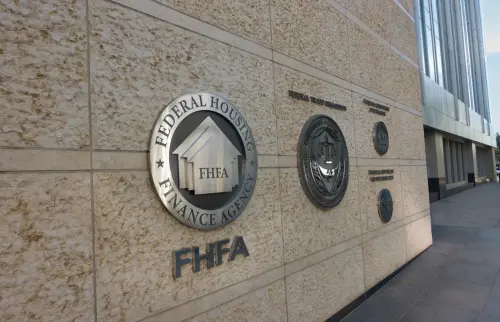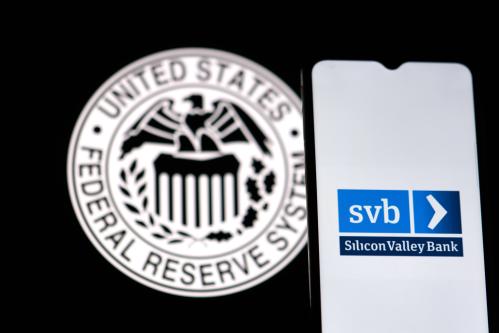Congress passed the Federal Home Loan Bank (FHLBank) Act in 1932 to support homeownership during the Great Depression. At its inception, the FHLBanks played an important role helping working families access financing to buy a home. Today, the FHLBanks have lost this focus—in favor of profit—and should again focus on encouraging member financial institutions to provide the type of financing that households need to thrive.
What are Federal Home Loan Banks?
The core function of the FHLBanks is to raise money in the capital markets that they can lend to member financial institutions. The FHLBanks can provide cheap financing because their debt has an implied government guarantee, which lowers their perceived risk and borrowing costs.1
The FHLBank system often toils in obscurity, but they are major players in the financial sector, with borrowings over one trillion dollars (real money even by government standards). For example, FHLBanks lent a massive amount of money to the two largest banks to fail since the financial crisis: Silicon Valley Bank (SVB) and First Republic. Interestingly, FHLBank officials did not testify at any of the Congressional hearings that followed.
FHLBank system’s mission: Housing or profit?
In its early days, this regime helped families access housing financing in two ways. First, it enhanced the viability of thrifts (aka savings and loan associations or S&Ls) which played a central role in housing finance. Thrifts, like banks, use shorter term liabilities to fund longer term assets, namely mortgages. But, in 1932, thrifts lacked access to the Federal Reserve (Fed). Thus, one function of the FHLBank system was to enhance the resilience of thrifts just as the Federal Reserve enhances the resilience of banks.2
Second, the FHLBanks encouraged thrifts to extend home loans that served the needs of working families. Using the carrot of cheap and stable financing, the FHLBanks rewarded thrifts when they made loans that had longer durations and other features favorable to borrowers, like the 30-year fixed rate mortgage.
The world has changed a lot since 1932. Today, banks and thrifts are functionally the same, and both are eligible for support from the Fed and FHLBanks. The range of collateral that banks, thrifts, and other member financial institutions can post to access financing from the Fed and FHLBanks has expanded dramatically. FHLBanks previously supported the resilience of thrifts, but this job is better accomplished by the Fed, an organization designed for resilience and supervision. FHLBanks are designed to support housing finance and community development. However, since their members only need 10% of their assets in mortgages, many FHLBank loans do not support housing.3
Furthermore, FHLBanks impose policies that prioritize maximizing profits while minimizing risk to themselves over policies that could encourage member financial institutions to provide the type of financing that households and businesses need. FHLBanks distribute profits to members, whereas the Fed sends its profits to Uncle Sam. This leads to a tension within FHLBanks between their public mission to support housing finance and private incentive to maximize profit. We believe this tension has moved too far towards profit and FHLBanks are not adequately supporting what they were created for: housing.
The Federal Housing Finance Agency (FHFA), regulator of the FHLBank system, recently embarked on a rethink of the system, an important opportunity for needed structural change. FHFA asked for comments to which we submitted this formal response. Below is a summary of our key points.
Causes: Methods and incentives for profit
The FHLBank system lacks safeguards meant to focus FHLBanks on serving public interests. FHLBanks employ an army of lobbyists, member banks can arbitrage between FHLBanks, and FHLBank executives are paid far more than their Fed peers.
Lobbying
Over the past 10 years, FHLBanks have spent $29 million on registered lobbyists.4 One of the first things the FHFA did when they placed the two other government sponsored enterprises they regulate (Fannie Mae and Freddie Mac) into conservatorship was eliminate outside lobbying. Fed Regional Banks do not employ outside lobbyists—either should FHLBanks.
Arbitrage
Until the 1990s, banks could only operate in one state, and so they could only have membership at one FHLBank. However, changes to banking laws have allowed banks to operate in multiple states and thus be members of multiple FHLBanks. This gives banks the opportunity to make FHLBanks compete with one another for business. When considered in intersection with the FHLBanks’ profit motive, arbitrage can lower FHLBs standards and create a race to the bottom between FHLBanks.
Incentive-based compensation
FHLBank presidents earned on average $2.9 million in 2023, with the highest making $4.4 million.5 In 2022, FHLBank presidents made on average more than four times Federal Reserve Regional Bank President salaries while managing roughly six times fewer employees (and not having a voice in setting America’s monetary policy). The table below contrasts Fed and FHLBank president compensation and their operations in the six cities that have one of each.
| Bank | President compensation ($) (2022)[1] | # of employees (2022)[2] | # of branches excluding HQ (2024)[3] | Operating expenses/non-interest expense ($ thousands) (2022)[4] | Assets ($ millions) (2022)[5] |
|---|---|---|---|---|---|
| FHLBank Atlanta | $2,003,932 | 319 | 0 | $138,000 | $151,622 |
| Fed Bank Atlanta | $443,100 | 1,814 | 5 | $500,162 | $603,124 |
| FHLBank Boston | $2,009,612 | 188 | 0 | $91,000 | $62,898 |
| Fed Bank Boston | $462,365 | 1,273 | 0 | $408,332 | $222,488 |
| FHLBank Chicago | $1,634,547 | 495 | 0 | $244,000 | $126,853 |
| Fed Bank Chicago | $477,900 | 1,679 | 1 | $482,900 | $578,801 |
| FHLBank Dallas | $1,790,916 | 201 | 0 | $102,000 | $114,349 |
| Fed Bank Dallas | $440,600 | 1,303 | 3 | $266,322 | $431,596 |
| FHLBank New York | $2,321,427 | 327 | 0 | $200,000 | $157,391 |
| Fed Bank New York | $528,800 | 2,971 | 0 | $2,000,955 | $4,429,847 |
| FHLBank San Francisco | $2,408,408 | 297 | 0 | $162,000 | $121,056 |
| Fed Bank San Francisco | $512,300 | 1,913 | 4 | $496,984 | $889,653 |
[1] Federal Home Loan Banks, Combined Financial Report for the Year Ended December 31, 2022 (issued March 24, 2023), S-14, https://www.fhlb-of.com/ofweb_userWeb/resources/2022Q4CFR.pdf; Board of Governors of the Federal Reserve System, 109th Annual Report, Table G.12.
[2] Federal Home Loan Banks, Combined Financial Report for the Year Ended December 31, 2022, 26; Board of Governors of the Federal Reserve System, 109th Annual Report, Table G.12.
[3] Federal Home Loan Banks, Combined Financial Report for the Year Ended December 31, 2022, 41; “Federal Reserve Banks,” About the Fed, Board of Governors of the Federal Reserve System, Accessed June 28, 2024, https://www.federalreserve.gov/aboutthefed/federal-reserve-system.htm.
[4] Federal Home Loan Banks, Combined Financial Report for the Year Ended December 31, 2022, F-82-F-83; Board of Governors of the Federal Reserve System, 109th Annual Report, Table G.9.
[5] Federal Home Loan Banks, Combined Financial Report for the Year Ended December 31, 2022, F-78-F-79; Board of Governors of the Federal Reserve System, 109th Annual Report, Table G.8A.
Obscuring and worsening financial instability
FHLBanks can obscure financial stability risk from bank regulators such as the Fed because they have become a “lender of next-to-last-resort.”6 The Fed is designed to serve as this nation’s lender of last resort. This includes mechanisms for ensuring accountability. Allowing banks and thrifts to go the FHLBanks instead undermines this regime and can allow problems at banks to fester.7
For example, Heartland Tri-state Bank’s executive lost millions of the bank’s money in a crypto scam causing the bank to fail. Yet Heartland managed to borrow a substantial share of the bank’s asset base from an FHLBank despite not having borrowed from an FHLBank in years.
Consequences: Taxpayers pay for FHLBank profits
The Congressional Budget Office estimates the total government subsidy for FHLBanks is roughly $7 billion a year.8 Policy makers need to ensure that people trying to own a home as part of the American dream are receiving these benefits, not corporate executives or bank shareholders.
FHLBanks paid in full before the FDIC
Prior to SVB’s collapse, the FHLBank of San Francisco loaned SVB $30 billion. When SVB imploded, the FHLBank of San Francisco got the $30 billion back while the Federal Deposit Insurance Corporation (FDIC) lost $16 billion providing insurance to depositors. FHLBanks are paid in full before depositors because they demand excess collateral and enjoy a legal “super-lien” that grants FHLBs first rights over the FDIC and Federal Reserve.9
Five solutions for the FHLBank system
- Focus FHLBank liquidity on supporting housing and community financing, not general cheap financing for banks.
- Single FHLBank district membership to stop arbitrage.
- Consider the appropriateness of FHLBank usage of private lobbyists.
- Stronger executive compensation rules, bringing the structure and level of compensation more in line with Fed Regional Banks.
- Consider using FHLBanks’ flexible financing system to target the liquidity gap for 5–49-unit residential buildings. Projects between 5-49 units are too large for Fannie and Freddie but too small to be worth it for large commercial banks. FHLBanks are well-positioned to fill the gap.
The FHFA’s review of the FHLBank system is an opportunity for change. By restoring their original purpose while mapping onto the modern financial system, the FHFA can promote access to affordable housing while reducing financial stability risk and taxpayer exposure.
-
Acknowledgements and disclosures
The Brookings Institution is financed through the support of a diverse array of foundations, corporations, governments, individuals, as well as an endowment. A list of donors can be found in our annual reports published online here. The findings, interpretations, and conclusions in this report are solely those of its author(s) and are not influenced by any donation.
-
Footnotes
- Jim Parrott and Mark Zandi, In Defense of the Federal Home Loan Banks (April 10, 2023), https://www.urban.org/research/publication/defense-federal-home-loan-banks.
- Herbert Hoover, “Statement About Signing the Federal Home Loan Bank Act” (Statement, Online by Gerhard Peters and John T. Woolley, The American Presidency Project, July 22, 1932), https://www.presidency.ucsb.edu/documents/statement-about-signing-the-federal-home-loan-bank-act.
- David Torregrosa, Remy Mitchell, and Sebastien Gay, The Role of Federal Home Loan Banks in the Financial System (Washington D.C., Congressional Budget Office, March 2024), https://www.cbo.gov/publication/60064.
- “Council of Federal Home Loan Banks Profile: Summary,” Organizations Summary, OpenSecrets, 2024, https://www.opensecrets.org/orgs/council-of-federal-home-loan-banks/summary?contribcycle=2024&id=D000049792&lobcycle=2024&outspendcycle=2022&topnumcycle=2024&toprecipcycle=2024; “Federal Home Loan Bank Profile: Summary,” Organizations Summary, OpenSecrets, 2024, https://www.opensecrets.org/orgs/federal-home-loan-bank/summary?contribcycle=2024&id=D000025773&lobcycle=2024&outspendcycle=2022&topnumcycle=2024&toprecipcycle=2024.
- Aaron Klein and Kathryn Judge, “Comments on the Federal Home Loan Bank mission,” The Brookings Institution, July 15, 2024, https://www.brookings.edu/articles/comments-on-the-federal-home-loan-bank-mission/; Federal Home Loan Banks, Combined Financial Report for the Year Ended December 31, 2023 (issued Mar 22, 2024), S-14, https://www.fhlb-of.com/ofweb_userWeb/resources/2023Q4CFR.pdf.
- Adam B. Ashcraft, Morten L. Bech, and W. Scott Frame, “The Federal Home Loan Bank System: The Lender of Next-to-Last Resort?,” Journal of Money, Credit and Banking 42 (2010): 551.
- Adam B. Ashcraft, Morten L. Bech, and W. Scott Frame, “The Federal Home Loan Bank System: The Lender of Next-to-Last Resort?,” Journal of Money, Credit and Banking 42 (2010): 551.
- David Torregrosa, Remy Mitchell, and Sebastien Gay, The Role of Federal Home Loan Banks in the Financial System (Washington, D.C.: Congressional Budget Office, 2024), https://www.cbo.gov/publication/60064.
- An Overview of the Federal Home Loan Bank System (Washington D.C.: Federal Housing Finance Agency Office of Inspector General, March 31, 2023), 9, https://www.fhfaoig.gov/sites/default/files/WPR-2023-002.pdf.






Commentary
How to fix Federal Home Loan Banks
August 8, 2024